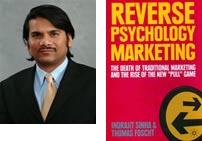"Don't shop here!" — Anti-Marketing may be the way to conduct effective marketing today
“Don’t shop here!” — Anti-Marketing may be the way to conduct effective marketing today
 Photo by Robert "Quinn" Hall
In center city Philadelphia, Denim Lounge makes no effort to identify itself between a bank and a pizza restaurant. Those in the know head past bouncers under an unmarked blue awning at 1712 Walnut Street to join other savvy clubbers upstairs.
|
Exclusive clubs with no outdoor signs. “Dove’s Campaign for Real Beauty.” “I hate Steven Singer.” These are just a few of the new “anti-marketing” campaigns running across the United States, bucking traditional marketing in favor of surprise, simplicity and exclusivity. Indrajit “Jay” Sinha, an associate marketing professor at The Fox School of Business, identifies and analyzes this new marketing trend in his new book, Reverse Psychology Marketing: The Death of Traditional Marketing and the Rise of the New “Pull” Game. After studying marketing campaigns and trends for several years, Sinha and his co-author, Austrian marketing professor Thomas Foscht, discovered that effective campaigns go against what traditional marketing preaches. |
|
According to Sinha, traditional marketing strategies are failing because people are no longer inspired by ‘over-marketing’ techniques. “People are jaded and tired of constantly being told what to do,” Sinha said. “They don’t want to be told to ‘buy this product,’ so this provides a fresh approach.”
|
|
|
Sinha |
“Just gear down the amount of offerings, and focus on the core offerings,” Sinha said. Across the globe, more and more “chef’s choice” restaurants are popping up. Customers come into the restaurant and eat whatever the chef prepared, without choosing from a menu. |
|
“Less is more with present-day marketing,” Sinha said. “Customers now crave simplicity, authenticity and exclusivity.” Sinha sites the example of Tommy Hilfiger. They opened too many flagship stores and the products started appearing in Costco, Dillard’s and Burlington Coat Factory, which diminished the brand’s credibility. In this new wave of marketing, advertisers are going out of their way to break away from being “politically correct.” To illustrate his point, Sinha referred to the infamous American Idol judge, Simon Cowell. “That’s essentially anti-marketing. He’s often cruel and quite rude to the contestants,” Sinha said of the Cowell. “He reduces some contestants to tears. But people like that because they see that he’s being authentic, and not worried about being politically correct.” With traditional marketing changing, those clinging to the old rules are paying a big price, Sinha said. “In anti-marketing, it’s not about following a script, but trying to pique interest by trying to make products seem unreachable.” For example, Sinha points out that many restaurants’ commercials don’t give their locations, giving them a mystery appeal. Those practicing similar new pull-marketing strategies include stores like Abercrombie & Fitch and Hollister. Some of them have shutters on their windows in the malls, making customers feel as if they are walking into a private club. “They want to generate curiosity, and give the customers the idea something mysterious is going on inside,” he said. Other examples Sinha highlights are billboard and radio ads that say “I Hate Steven Singer,” which have proved to be extremely effective. These ads are so intriguing that people immediately go home and “Google” Steven Singer. It turns out that Singer is a jeweler in Philadelphia. So why the hatred? According to the company’s Web site, women like Steven Singer so much, they become obsessed, forcing men to spend too much money there. Another one of the reverse-psychology marketing strategy is Dove’s Campaign for Real Beauty. “They take full-figured women and women with blemishes, and make them models the general audience can look up to,” Sinha said. In his book, Sinha points out that the new marketing zeitgeist involves a widespread craving for natural products, a desire for simpler items and a general nostalgia for traditional things. Sinha observes that the rise of Whole Foods and bottled water have encouraged marketers to embrace the use of nature, and that the Apple iPod’s phenomenal success is due to the device’s simplicity. Sinha also notes that people today are embracing traditional cultures, evidenced by women buying pearl jewelry — a mainstay of 1940s fashion — and home buyers building “log cabin homes” with modern amenities. “We want to make executives aware that this important trend is happening on the fringe of this marketing,” Sinha said of his book. “They should reframe their business to accommodate these new trends.” Sinha’s academic research focuses on the meaning and symbolism of brands in contemporary society, and their role in the age of globalization, the Internet and mobile communications. He has taught in business schools all over the world, and has published in prestigious marketing and strategy journals as Harvard Business Review, Journal of Marketing and Journal of Marketing Research. “Reverse Psychology Marketing,” was released by Palgrave Macmillian in January.
— By Rebecca C. Carroll For The Fox School of Business |
|
